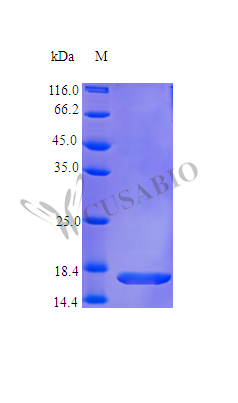The recombinant human tumor necrosis factor protein (TNF) was generated by the expression of a DNA fragment encoding 77-23aa of human TNF in the E.coli cells. The partial-length protein reached up to 98% in purity, which was measured through SDS-PAGE and HPLC analysis. It was also verified to be fully biologically active through a cytotoxicity assay using murine L929 cells (ED50 <0.05 ng/ml, specific activity >2.0x107 IU/mg). The endotoxin of this TNF is less than 1.0 EU/μg as determined by the LAL method. In-stock TNF proteins are offered now. Proteins carrying custom tags are also available. This recombinant TNF protein may find uses in the specific antibody synthesis or the cancer studies.
TNF, also called TNF-α, is a pro-inflammatory cytokine and a key mediator of inflammation. It exerts pro-inflammatory effects via TNF-α/TNFR signaling. When a person gets injured or contracts bacterial or viral infections, TNF triggers inflammation to protects people against infections and help the injury to heal. Whereas overexpressed TNF causes excess inflammation and even probably leads to autoimmune diseases. Inflammatory autoimmune conditions such as psoriatic arthritis, rheumatoid arthritis (RA), Crohn’s disease, among others are related to TNF. Anti-TNF therapy has been clinically put into use to control autoimmune diseases such as RA. Studies have shown that TNF can kill certain tumor cells.






